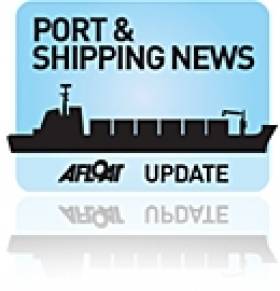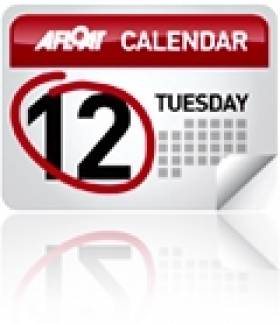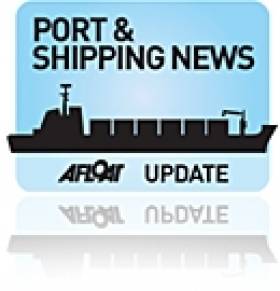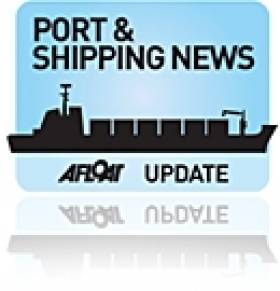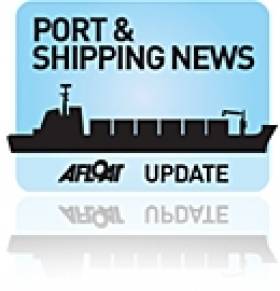Displaying items by tag: Shipping
Dublin Hosts Maritime Law Seminar Next Month
The latest Maritime Law Seminar hosted by the Irish Maritme Law Association (IMLA) will take place on Thursday 12 May 2011 in The Gibson Hotel at The Point Village in Dublin's Docklands.
Also open to non-members, the day will feature discussions on the areas of ship arrests, sale of goods, marine casualties and maritime jurisdiction.
The seminar fee is €100 for IMLA members (€130 for non-members) and bookings mist be made with payment by Tuesday 10 May.
A booking form with further details is available from the IMLA website.
The report shows that unitised traffic on the main Roll-on/Roll-off routes to the UK recovered by 4% in 2010, with a decline in the Lift-on/Lift-off container sector easing substantially compared to the 2009 with a fall of just 3%.
The strongest volume recovery occurred in the dry bulk segments which were up 18% Part of the return to growth in this sector is attributed to strong global demand for ore and mineral products such as alumina, while domestic demand in the agricultural sector led to a rise in the imports of grains, feeds and fertilizers. Although the overall picture is positive; the main volume gains in this segment were not evenly distributed among the ports with some of the smaller regional ports still in negative territory for the year. Tanker and liquid bulk volumes were up 2%, while ferry passenger volumes also increased for the full year by 4%.
"We have seen many ports and shipping segments recover some of the heavy losses which occurred over the past two years," said IMDO Director Mr. Glenn Murphy. "The trend in shipping data appeared to closely follow the general economic climate last year with a strong start to 2010, before wider economic concerns over the third quarter contributed to the general slow down at the year end."
The report also highlights the continued resilient performance of export trades with estimates that export volumes on the principle routes to the UK, Asia and US were up overall by 7%. The underlying performance of multinational sectors, principally in chemical and pharmaceutical industries, led the export recovery while established indigenous Irish exporting companies, particularly in the food, drink and agri-business segments , also contributed to the strong performance. The report remarks however that imports in the principle segments linked to consumer and household demand remained subdued last year with no noticeable growth.
The report concluded that outlook for 2011 looks likely to be testing for the domestic ports and shipping sectors with less growth forecast across the majority of the shipping segments. The rise of bunker/fuel prices by 136% over the past 12 months will put further pressure on operators to increase freight rates and bunker surcharges. The full report can be read here.
Lecture: “The Circumnavigation – Continued”
For further information on the lectures to date click this link and in general about the DBOGA logon here. To contact the PYBC Tel: (01) 668 9983 or logon to www.poolbegmarina.ie/
Inspection of Refloated Ship in Galway Bay Under Way
Marine surveyors are currently inspecting the German cargo ship which was refloated yesterday in Galway Bay after running aground early on Thursday.
The Irish Coast Guard confirmed to The Irish Times that no pollution had occurred in the grounding of the Pantanal on the south Connemara coast.
The 120m vessel was refloated at high tide yesterday morning with help from the Celtic Isle tug from Foynes in Co Limerick.
Ship managers Harren & Partner said the hull would undergo a diver inspection before the vessel sails for dry dock.
Yesterday Minister for the Marine Simon Coveney welcomed the "successful operation in very challenging conditions" and confirmed a thorough investigation of the incident by the Marine Casualty Investigation Board.
The ship had been sailing from the Mediterranean to Rossaveal to collect two monohull ferries, sold to Mauritius, that had been built to serve the Aran Islands route.
The Irish Times has more on the story HERE.
How Many Times Do I Have to Say the Sea is Vital to Ireland?
Ireland has the largest maritime area-to-land mass in the European Union, but derives only 1% of GDP from the maritime sector. At a time when the economy needs every benefit it can get this figure is startling, particularly when compared to countries with other extensive coastlines, such as Norway where the figure is 20%, Denmark where it is 11% and even the UK which has increased its figure to 5%.
Despite being an island nation with a strong dependency on the sea, the Irish maritime economy is still in its infancy, both in terms of investment and of recognition.
Once again the importance of the sea was shown in the pre-Christmas weather problems. When air transport again failed the public, the ferries continued to operate. When road transport needed salt for gritting to keep roads open, it was ships which brought the salt to Ireland.
How many times do I have to challenge the ignorance and stupidity of the State, of Government, towards the sea? How many times do I have to remind the public of how dependent we are on the sea as an island nation?
Though still considered a low priority by Government, the maritime sector is worth €3 billion to the nation and supports 440,000 direct and indirect jobs. According to the Marine Institute in the "SeaChange Programme," this could be increased by at least 50%.
In Cork the Coastal and Marine Resources Centre which is part of UCC's Environmental Research Institute and has been working out of the Naval Base on Haulbowline Island has changed its name and is planning to move to a new maritime research facility. It has become the "Coastal and Marine Research Centre".
For over ten years the CMRC has been promoting the use of integrated coastal zone management as a means of achieving sustainable development in the use of coastal and marine resources, including marine ecology, seabed mapping, coastal processes, remote sensing, geology and geomatics.
A new maritime research facility is planned at Ringaskiddy, adjacent to the National Maritime College, part of the announced intention to establish a Maritime and Energy Research Campus and Commercial Cluster. The Department of Communications, Energy and Natural Resources, Bord Gais and the UCC Glucksman Foundation contributed funding, together with €7.5m. from the Higher Education Authority. As part of the National Ocean Energy Strategy, it will "bring together on one site the people, their ideas and the infrastructure to support the development of ocean energy," according to MERC Chairman, Peter Coyle. "Our aim is to produce innovative technical solutions to support the development of the Irish maritime sector."
This will include ocean energy opportunities, such as wave power where Irish companies have been leading the way. Shipping, logistics and maritime transport, marine recreation, maritime security research and maritime space applications are amongst other aspects of research work to be undertaken in Ringaskiddy.
Valerie Cummins, who led the Coastal Marine Resources Centre over past years has been appointed Director of MERC and is being replaced as Director at the newly re-named Coastal and Marine Research Centre by Jeremy Gault.
This article is reprinted by permission of the EVENING ECHO newspaper, Cork, where Tom MacSweeney writes maritime columns twice weekly. Evening Echo website: www.eecho.ie
IMDO Release Third Quarter Shipping Figures
The latest figures announced by the Irish Maritime Development Office (IMDO) has revealed that the volume of goods passing through Irish ports increased across all the main shipping segments during the 3rd quarter of 2010 compared to the same period last year.
Exports of container were up 12%, roll-on/roll-off volumes on Ireland – UK routes is up 3%, dry bulk volumes up 40%, and liquid bulk up 19%.
Containersized traffic shipped through ROI ports recorded a quarter-on-quarter volume growth for the 3rd quarter 2010 up 4% to 218,377 twenty equivalent units (TEU). This was primarily as a result of strong export demand, which rose by 12% in the last quarter.
This sector is characterized by export traffic to USA and Asia largely influenced by the multinational chemical and pharmaceutical industries and also established indigenous Irish exporting companies. The other factor contributing to the aggregate rise was the increase in container imports during this period. This was also the first quarter-on-quarter growth in import volumes since the beginning of 2009.
Roll-on/roll-off (ro/ro) traffic to the UK from ROI ports continued to make a steady recovery up 3% for the 3rd quarter which is consistent with overall figures for the 9 months from Jan – Sept period which is up 3%, to 568,833 units. The ro/ro segment is largely weighted towards services to and from the UK which remains our largest trading partner.
In the dry bulk trade, traffic through all Irish Ports continued to recover some of the large volume losses experienced in 2009 and is up 40% for the 3rd quarter compared to the same period last year and 26% for the first 9 months of 2010. Part of the rise is attributed to strong global demand for ore and mineral products such as alumina, while domestic demand in the agricultural sector experienced a rise in imports of grains, feeds and fertilizers. While the overall picture is positive; the main volume gains are distributed to the larger ports with some of the smaller regional ports still in negative territory.
Break bulk volumes of construction related products fell again in the third quarter, bringing the total decline for the third quarter to -10%. Between 2008 and 2010 over 700,000 tonnes of break bulk commodities have been lost from the market. Importantly the fall off in volumes has not slowed in 2010 with an average quarterly drop of 10%.
Liquid bulk volume rose in Q3 by 19% year-on-year. However overall volumes for the first 9 months of the year remain unchanged.
The outlook for the remainder of the year suggests that some volume recovery in the main market segments will be achieved this year. However the total volume in many segments are still running at 35% less than 2007 volumes. Many shipping operators also comment that while export volumes have remained resilient over this period, there are few new companies emerging in the export market. Otherwise there are concerns about the impact of austerity measures in the Euro zone and at home.
Source: Glenn Murphy, Director of the IMDO. For more about the IMDO logon here.
Toxic Gases in Cargo Pose 'Substantial Health Risk'
European Union members must solve the problem of toxic gases in shipping cargo, says a new Dutch-based action group.
TGAV (Toxic Gases and Vapors) claims that research suggests more than one in 10 of all cargo containers throughout the EU "may have too high a concentration of hazardous gases or vapours".
The group says that these fumes are likely byproducts of the manufacturing process for a wide range products, from electronics and shoes to wooden furniture, clothing and toys, and even dried fruit.
"One example is the release of vapours from the glue used in sport shoes," it says. "After a three-week sea journey from China to for instance Europe, the concentration of gases and vapours can sometimes reach considerable levels."
The group adds: "The health risks for workers are substantial; in Germany and the Netherlands, several dozen cases of work disability are known in relation to the opening of containers."
TGAV notes that significant problems include the lack of warning labels on such potentially hazardous cargo, and low awareness within the logistics sector regarding the risks involved.
"In Europe, there is growing attention for the problem, but no coherent policy," says the group. "In order to ensure fair competition, a uniform approach should be implemented."
TGAV will host a conference next month in Brussels where the prospect of an EU policy on the problem will be discussed.
Irish Shipping Trade Volumes Return to Growth
The midyear data in particular points towards trade volume growth in three of the principal freight segments; most significantly in lift-on/ lift-off (lo/lo) export trades which we estimate grew by 5%. Roll-on/Roll-off export traffic was also up 5% per cent on an all island basis. Dry bulk volumes through ROI ports increased by 15% for the first six months compared to the same period last year. Shipments in April this year saw the strongest monthly volume of bulk cargoes in over 2 years.
Roll-on/roll-off (ro/ro) traffic on an all-Island basis continued to make a steady recovery with an increase of 2%, up to 771,585units for the first half of 2010. The ro/ro segment is largely weighted towards services to and from the UK which remains our largest trading partner.
The most significant change in volume has been in the main lo/lo trades. Overall total volume including export and imports fell only marginally by 1% to June with 517,552 units being handled. However this compares to a -24% reduction for the same periods last year.
A key factor in the positive upward movement has been the continued strong performance of export volumes which as noted was up 5% year on year. Import volumes were down 2% which is largely as a result of continued weak domestic demand. Nonetheless the rate of decline in import volumes has eased sharply which is possibly also offset by demand for industrial imports used as inputs for the merchandise export trades.
The sharp fall in import units over the last 24 months has inversely created a problem for export companies as there is now reduced supply of export quality containers available in Ireland. As a result shipping lines have to reposition empty containers from the UK and Continent which in turn adds to the overall cost of the export box.
Dry bulk (Bulk carrier) trades recovered some of the record volume losses seen in 2009 with a strong 15% increase between January and June. Part of this recovery is attributed to stronger domestic demand for grains, fertilizers and other agricultural products, while improved global demand for steel and other ore aggregates also pushed up volume throughput.
Breakbulk volumes through ROI ports linked to construction inventories such as steel and timber continued to decline by 11%, which is half the recorded figure for 2009. Nonetheless volume activity in this segment remains at a historically low level.
Liquid bulk (Tanker) volumes such as oil fell by 4%, with lower transshipment storage for the US market and other seasonal factors impacting on demand. The outlook for continued short term volume recovery remains largely contingent on the external recovery in the global economy.
Delegates Discuss Shortsea Shipping Sector in Dublin
Two hundred delegates, including many of Europe's senior port and shipping executives, gatheredfor the Annual European Shipping Congress at Dublin Castle, today (29th, June 2010) to discuss the current state of the European Shortsea shipping and port sector.The event, which was organised by the Irish Maritime Development Office (IMDO) was formally opened by Minister Ciaran Cuffe, Minister of State at the Department of Transport. The theme of the Congress was "strategies and opportunities for recovery in European Shortsea Shipping".Speaking at the conference Mr Fran Dodd, Logistics Manager of the Irish Dairy Board said "Competitive shortsea shipping has been fundamental to our success and is fundamental to our future" IDB export 100% of their products, including Kerrygold brand to over 80 countries worldwide.
Major Irish exporting companies such as Irish Dairy Board, Wellman International and Rusal, (the worlds largest alumina and aluminium producer with a major facility in on the Shannon Estuary), all provided key note papers on their perspective for export led recovery."This year's congress is taking place at a time when the industry is still concerned about the pace and fragility of the recovery in the European economic zone, said IMDO Director Glenn Murphy. "The European shipping sector has endured a highly turbulent 18 months which has seen shipping demand and port throughput fall right across Europe. This has resulted in most market segments having to deal with capacity issues and falling freight rates. The Congress appears optimistic but still highly cautious of the volatile nature of the recovery path for the sector"In his opening address Minister Cuff welcomed that Ireland had become a recognised location where leaders from across Europe now come to regularly discuss key shipping and port issues. "I am particularly pleased to note that, although issues such as cost and capacity where very much to the fore of the industry agenda, highly important areas such as climate change and vessel emissions were also being debated at the congress," he said.
The European Shipping Congress is now scheduled to be held in Ireland every alternate year and is scheduled to return in 2012 after being hosted in Germany in 2011.
Two hundred delegates, including many of Europe's senior port and shipping executives, gatheredfor the Annual European Shipping Congress at Dublin Castle, today (29th, June 2010) to discuss the current state of the European Shortsea shipping and port sector.
The event, which was organised by the Irish Maritime Development Office (IMDO) was formally opened by Minister Ciaran Cuffe, Minister of State at the Department of Transport. The theme of the Congress was "strategies and opportunities for recovery in European Shortsea Shipping".
Speaking at the conference Mr Fran Dodd, Logistics Manager of the Irish Dairy Board said "Competitive shortsea shipping has been fundamental to our success and is fundamental to our future" IDB export 100% of their products, including Kerrygold brand to over 80 countries worldwide.
Major Irish exporting companies such as Irish Dairy Board, Wellman International and Rusal, (the worlds largest alumina and aluminium producer with a major facility in on the Shannon Estuary), all provided key note papers on their perspective for export led recovery.
"This year's congress is taking place at a time when the industry is still concerned about the pace and fragility of the recovery in the European economic zone, said IMDO Director Glenn Murphy. "The European shipping sector has endured a highly turbulent 18 months which has seen shipping demand and port throughput fall right across Europe. This has resulted in most market segments having to deal with capacity issues and falling freight rates. The Congress appears optimistic but still highly cautious of the volatile nature of the recovery path for the sector"
In his opening address Minister Cuff welcomed that Ireland had become a recognised location where leaders from across Europe now come to regularly discuss key shipping and port issues. "I am particularly pleased to note that, although issues such as cost and capacity where very much to the fore of the industry agenda, highly important areas such as climate change and vessel emissions were also being debated at the congress," he said. The European Shipping Congress is now scheduled to be held in Ireland every alternate year and is scheduled to return in 2012 after being hosted in Germany in 2011.
The latest figures from the Irish Maritime Development Office (IMDO) on Irish shipping and port traffic data for the first quarter of 2010 indicate a continued general easing in the rate of decline in freight volumes. The IMDO estimate that 2 of the principal 5 freight segments measured indicated modest growth over this period. However while the rate of decline has moderated the overall recovery has been uneven both in the mode of transport and also the distribution of traffic around the island with larger gateway ports on average performing better than smaller regional ports. The first quarter data is also slightly skewed by significant weather disruption which occurred over the first 4 weeks of the year which is likely to have impacted on several key trades.
Roll-on/roll-off (ro/ro) traffic on an all-Island basis grew 5% in the first quarter 2010 when compared to Q1 2009. The Ro/RO segment is largely weighted towards services to and from the UK. Traffic movements on these corridors have been less exposed to the downturn in construction based inventories but connected to longer establish trading segments.
Lift-on/lift-off (lo/lo) traffic through Irish ports declined 7% in the 1st quarter, when compared to the same period in 2009 with 239,643 units being handled at all Irish ports. Lo/Lo volumes have historically been driven by imports linked to strong domestic and residential demand. Import volumes fell again by 9% but the decline is less severe than the 27% fall in the corresponding period in 2009. Laden container exports were down 1% which again compares positively to the 21% decline 12 months earlier and supports general optimism of an export led recovery. Export volumes are likely to have also been impacted by the poor weather conditions in January and might otherwise have been stronger. Lo/Lo volumes likely to only recover at a slower pace as concerns about retail consumer sentiment prevail. Incumbent operators have continued to reduce the supply of shipping capacity made with an increase in vessel sharing arrangements between operators and further consolidation of routes occurring in the early part of the year.
Volumes in the key bulk sectors appeared to move towards recovering from the record volume declines in 2009 where more than 33% of total volume was lost. Total bulk volumes through ROI ports fell just 1% in the first three months of 2010 with dry bulk volumes down 2% although with some recovery observed figures in fertilizers and aggregates to 3.05million tonnes while liquid bulk volumes grew by 1% helped by the cold weather period. Breakbulk volumes linked to construction inventories declined by 20% to 63,000 tonnes with limited prospects of a return to previous volumes seen in 2007 when the corresponding figure was 160,00 tonnes.
As highlighted earlier, there is no doubt that overall freight traffic volumes were impacted by the significant weather disruption caused to trade and manufacturing output. We also observed certain re-distribution of traffic volumes between ports over the past quarter. While some key segments recorded negative growth the rate of volume erosion is still substantially less than 12 months earlier when large amounts of tonnage capacity dissipated as the sector adjusted abruptly to the change in the economy.
The fundamentals in terms of the number of shipping companies active and competing for market share in the principal Irish freight markets is still strong. The outlook for short term volume recovery remains largely contingent on the continued external recovery in the global economy. A weaker euro is also likely to boost our export potential to major overseas markets, however oil and bunker prices have continued to steadily rise during the first quarter and will also be marginally more expensive in dollar terms.





























